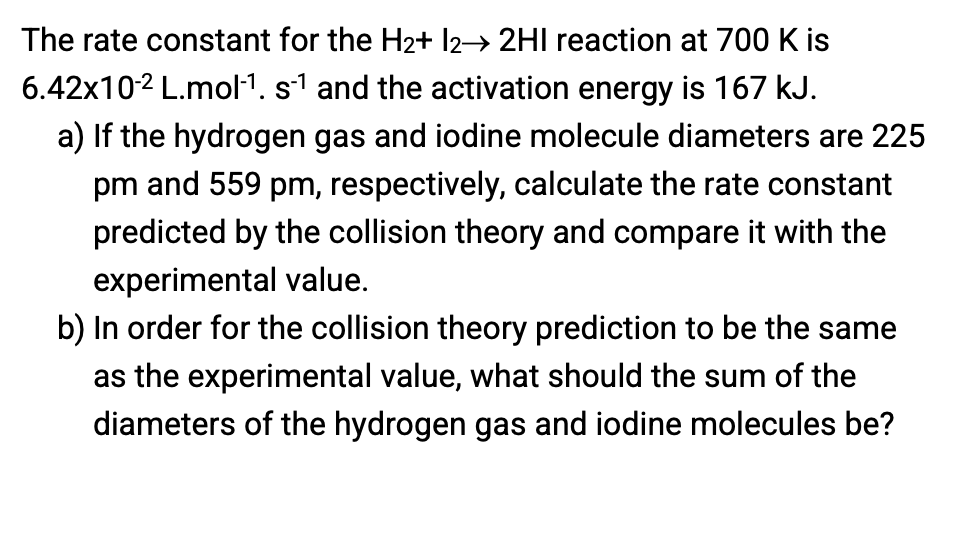The rate constant for the H2+ l2→ 2HI reaction at 700 K is 6.42x102 L.mol1. s1 and the activation energy is 167 kJ. a) If the hydrogen gas and iodine molecule diameters are 225 pm and 559 pm, respectively, calculate the rate constant predicted by the collision theory and compare it with the experimental value. b) In order for the collision theory prediction to be the same as the experimental value, what should the sum of the diameters of the hydrogen gas and iodine molecules be?
The rate constant for the H2+ l2→ 2HI reaction at 700 K is 6.42x102 L.mol1. s1 and the activation energy is 167 kJ. a) If the hydrogen gas and iodine molecule diameters are 225 pm and 559 pm, respectively, calculate the rate constant predicted by the collision theory and compare it with the experimental value. b) In order for the collision theory prediction to be the same as the experimental value, what should the sum of the diameters of the hydrogen gas and iodine molecules be?
Principles of Modern Chemistry
8th Edition
ISBN:9781305079113
Author:David W. Oxtoby, H. Pat Gillis, Laurie J. Butler
Publisher:David W. Oxtoby, H. Pat Gillis, Laurie J. Butler
Chapter18: Chemical Kinetics
Section: Chapter Questions
Problem 36P
Related questions
Question

Transcribed Image Text:The rate constant for the H2+ l2→ 2HI reaction at 700 K is
6.42x102 L.mol1. s1 and the activation energy is 167 kJ.
a) If the hydrogen gas and iodine molecule diameters are 225
pm and 559 pm, respectively, calculate the rate constant
predicted by the collision theory and compare it with the
experimental value.
b) In order for the collision theory prediction to be the same
as the experimental value, what should the sum of the
diameters of the hydrogen gas and iodine molecules be?
Expert Solution
This question has been solved!
Explore an expertly crafted, step-by-step solution for a thorough understanding of key concepts.
Step by step
Solved in 3 steps with 3 images

Knowledge Booster
Learn more about
Need a deep-dive on the concept behind this application? Look no further. Learn more about this topic, chemistry and related others by exploring similar questions and additional content below.Recommended textbooks for you

Principles of Modern Chemistry
Chemistry
ISBN:
9781305079113
Author:
David W. Oxtoby, H. Pat Gillis, Laurie J. Butler
Publisher:
Cengage Learning

Chemistry: The Molecular Science
Chemistry
ISBN:
9781285199047
Author:
John W. Moore, Conrad L. Stanitski
Publisher:
Cengage Learning

Chemistry: Principles and Practice
Chemistry
ISBN:
9780534420123
Author:
Daniel L. Reger, Scott R. Goode, David W. Ball, Edward Mercer
Publisher:
Cengage Learning

Principles of Modern Chemistry
Chemistry
ISBN:
9781305079113
Author:
David W. Oxtoby, H. Pat Gillis, Laurie J. Butler
Publisher:
Cengage Learning

Chemistry: The Molecular Science
Chemistry
ISBN:
9781285199047
Author:
John W. Moore, Conrad L. Stanitski
Publisher:
Cengage Learning

Chemistry: Principles and Practice
Chemistry
ISBN:
9780534420123
Author:
Daniel L. Reger, Scott R. Goode, David W. Ball, Edward Mercer
Publisher:
Cengage Learning

Chemistry & Chemical Reactivity
Chemistry
ISBN:
9781133949640
Author:
John C. Kotz, Paul M. Treichel, John Townsend, David Treichel
Publisher:
Cengage Learning

Chemistry & Chemical Reactivity
Chemistry
ISBN:
9781337399074
Author:
John C. Kotz, Paul M. Treichel, John Townsend, David Treichel
Publisher:
Cengage Learning

Physical Chemistry
Chemistry
ISBN:
9781133958437
Author:
Ball, David W. (david Warren), BAER, Tomas
Publisher:
Wadsworth Cengage Learning,